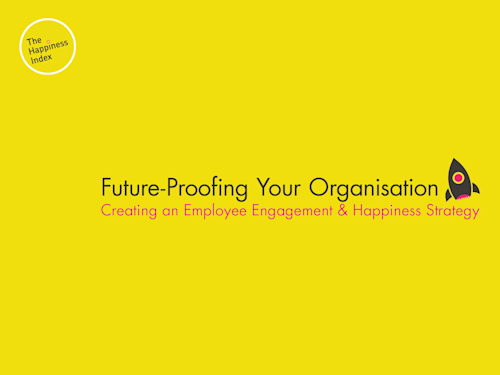
Creating an Employee Engagement AND Happiness Strategy
At the Happiness Index, we speak to loads of CEOs and HR directors every single day. Lots of them come to us with variations of a similar story – their employee engagement metrics are at record high levels but they’re still losing great, valued staff, who are complaining about being unhappy. So what's going on and how can you create a happy workplace?
We believe that the employee engagement model is broken. We believe that the real problem is that emotions have been banned from the workplace.
Like a lot of things we know and love today – trains, photographs, and even the forefather of the keyboard on which I’m writing this – the way we work today has its roots in the Industrial Revolution. People were moving out of the countryside and its seasonal ways of working and into cities and factories where work was done in one place at one time. Humans became an essential cog in the biggest and most enduring of late 18th century inventions – the factory.
The post-industrialisation way of working takes a lot of what makes us human out of the workplace. We’ve divided the brain and the heart in the pursuit of profits. The hierarchical way our businesses are structured, and the command and control systems through which we work are direct descendants of the organisation of the factory floor. And here’s the thing, if you treat humans like machines, eventually they break.
Today we’re seeing record levels of burnout, mental health is at an all-time low, and companies are struggling to attract and maintain talent. All of this has a direct impact on productivity and performance.
We've completely removed emotions from the workplace. They’re labelled as unnecessary and unprofessional. We leave our emotions at home and bring our rational thinking to the workplace. This complete separation of our thinking and feeling brains is counter-intuitive, counter-productive, and ultimately counter-human. We’ve broken what it is to be human, and those who buy into this broken system are rewarded.
We’ve been trained our whole lives from school to the workplace to chase these rewards. We hope that eventually the road we’re following will lead to success, paid bills and ultimately happiness.
The problem is, of course, that we’re going about all this in the completely wrong direction. We’re chasing the right things… we’re just doing it in the wrong order!
Increasingly, research and observable evidence is showing us that success does not lead to happiness. Happiness leads to success.
Let that sink in a minute.
Happiness leads to success.
Don’t believe us? Well perhaps this 2005 paper by Sonia Lyubomikrsky, and her colleagues Ed Diener and Laura King, will convince you. If reading a whole scientific paper is a bit much, here’s the gist:
We have reviewed extensive evidence demonstrating that happy people are successful and flourishing people. Part of the explanation for this phenomenon undoubtedly comes from the fact that success leads to happiness. Our review, however, focuses on the reverse causal direction—that happiness, in turn, leads to success. Happy people show more frequent positive affect and specific adaptive characteristics. Positive affect has been shown, in experimental, longitudinal, and correlational studies, to lead to these specific adaptive characteristics. Thus, the evidence seems to support our conceptual model that happiness causes many of these successful outcomes with which it correlates.
Of course, the world has changed a lot since 2005, and so has happiness research. Study after study has supported these findings, as does the millions of customer data points we’ve collected at The Happiness Index.
Trying to stick rigidly to an antiquated system is killing your organisation. And not quickly and painlessly. It’s a slow drawn-out death which is harming your people in the process. We don’t use the same locomotives, cameras or typewriters as we did during the industrial revolution, so why use the working methods?
We think the solution to the situation we’ve outlined here is obvious. We need to bring emotions, happiness first and foremost, back into the equation. Happiness, much like revenue and productivity, is a data point which you can use to measure the success of your organisation. Improved employee happiness can be achieved in many ways but will be different across every organisation as the people and their priorities differ, for example work-life balance may be at the forefront of your employees' agenda, therefore consider ways to support this.
The key, here, is not to think of happiness as a metric which competes with your other KPIs and goals, but rather to see it as one that supports your organisational goals. Happiness, productivity and even your bottom line are all interconnected parts of the same ecosystem. You can’t achieve true success as a business without all three.

Linked to Happiness in our neuroscience methodology... learn more
The Happiness Index helps organisations measure the key employee engagement AND happiness drivers to power their people strategy.
Our unique platform offers the products, insights and tools to shine a light on your cultural health and empower management to drive thriving cultures.
Our neuroscience-based pre-built surveys measure the full employee experience - from onboarding to exit to empower and enable organisations to understand their people and create data-led action plans.
